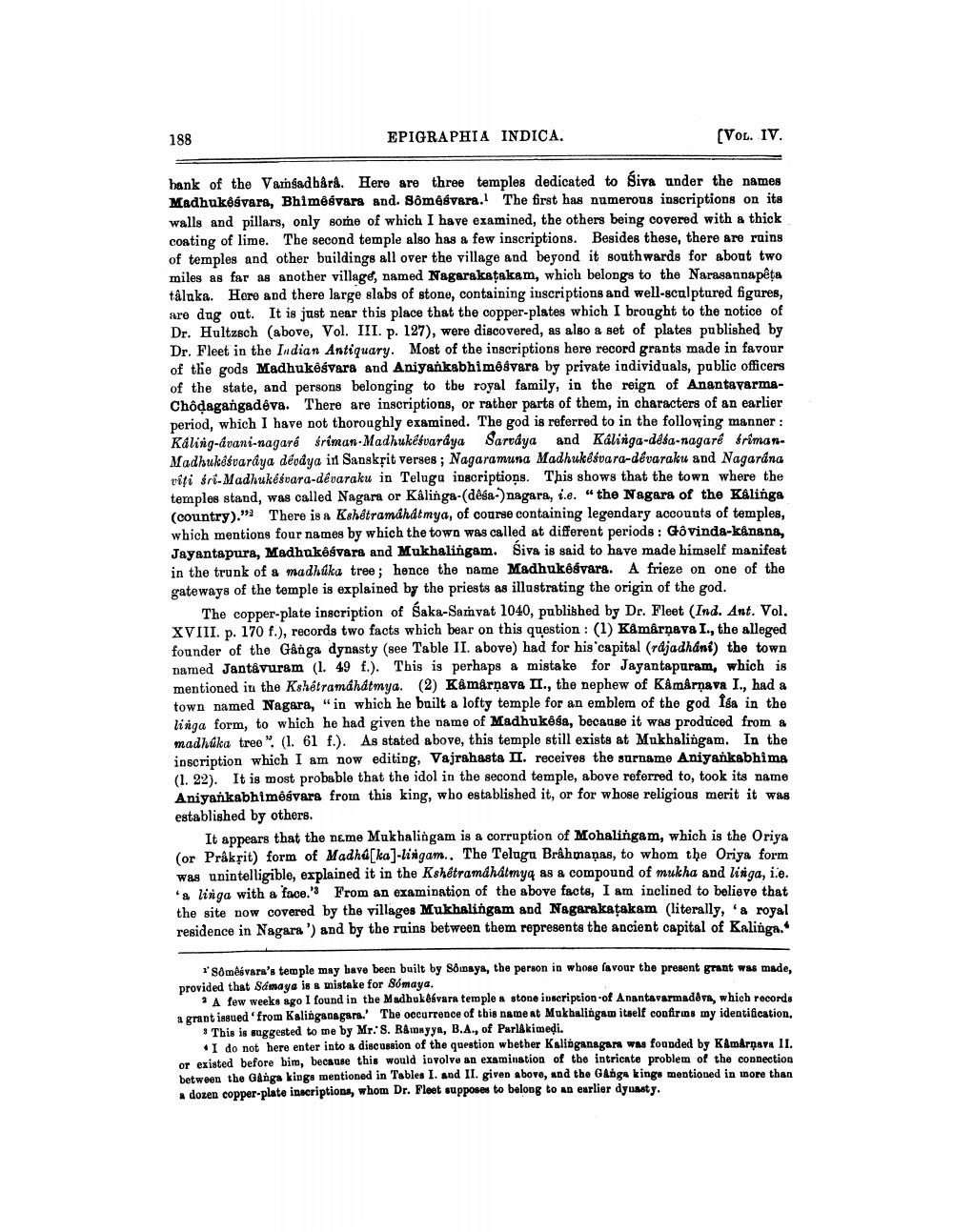________________
188
EPIGRAPHIA INDICA.
(Vol. IV.
hank of the Vamsadbára. Here are three temples dedicated to Siva under the names Madhukėgvara, Bhimégvara and. Sômêsvara. The first has numerous inscriptions on its walls and pillars, only some of which I have examined, the others being covered with a thick coating of lime. The second temple also has a few inscriptions. Besides these, there are ruins of temples and other buildings all over the village and beyond it southwards for about two miles as far as another village, named Nagarakatakam, which belongs to the Narasannapêta tâlnka. Here and there large slabs of stone, containing inscriptions and well-sculptured figures, are dug out. It is just near this place that the copper-plates which I brought to the notice of Dr. Hultzsch (above, Vol. III. p. 127), were discovered, as also a set of plates published by Dr. Fleet in the Indian Antiquary. Most of the inscriptions here record grants made in favour of the gods Madhukógvara and Aniyankabhimêsvara by private individuals, public officers of the state, and persons belonging to the royal family, in the reign of AnantavarmaChôdagangadêva. There are inscriptions, or rather parts of them, in characters of an earlier period, which I have not thoroughly examined. The god is referred to in the following manner : Kaling-ávani-nagaré sriman- Madhukékvaráya Sartdya and Kalinga-ddda-nagarê SrimanMadhukestaráya déodya in Sanskřit verses; Nagaramuna Madhukêśvara-dévaraku and Nagardna vifi &ri-Madhukesvara-devaraku in Teluga inscriptions. This shows that the town where the templos stand, was called Nagara or Kalinga-(déśa-)nagara, i.e. "the Nagara of the Kalinga (country)." There is a Kshetramdhatmya, of course containing legendary accounts of temples, which mentions four names by which the town was called at different periods : Govinda-kenang, Jayantapura, Madhukėśvara and Mukhalingam. Siva is said to have made himself manifest in the trunk of a madhúka tree; hence the name Madhukesvara. A frieze on one of the gateways of the temple is explained by the priests as illustrating the origin of the god.
The copper-plate inscription of Saka-Samvat 1040, published by Dr. Fleet (Ind. Ant. Vol. XVIII. p. 170 f.), records two facts which bear on this question : (1) Kamârnava I., the alleged founder of the Ganga dynasty (see Table II. above) had for his 'capital (rdjadhani) the town named Jantâvuram (1.49 f.). This is perhaps a mistake for Jayantapuram, which is mentioned in the Kshetramáhatmya. (2) Kamârnava II., the nephew of Kamârnava I., had a town named Nagara, "in which he built a lofty temple for an emblem of the god Isa in the linga form, to which he had given the name of Madhukėga, because it was produced from a madhaka tree". (1. 61 f.). As stated above, this temple still exists at Mukhalingam. In the inscription which I am now editing, Vajrahasta II. receives the surname Aniyankabhima (1. 22). It is most probable that the idol in the second temple, above referred to, took its name Aniyankabhimêsvars from this king, who established it, or for whose religious merit it was established by others.
It appears that the name Mukhalingam is a corruption of Mohalingam, which is the Oriya (or Prekrit) form of Madha[ka]-lingam., The Telugu Brahmaņas, to whom the Oriya form was unintelligible, explained it in the Kshetramáhatmyq as a compound of mukha and linga, i.e. a linga with a face.' From an examination of the above facts, I am inclined to believe that the site now covered by the villages Mukhalingam and Nagarakatakam (literally, 'royal residence in Nagara ') and by the ruins between them represents the ancient capital of Kalinga.
1' Somêsvara's temple may bave been built by Somaya, the person in whose favour the present grant was made, provided that Samaya is a mistake for Sómaya.
? A few weeks ago I found in the Madhuk@svara temple a stone inscription of Anantavarmadêrs, which records a grant issued 'from Kalinganagars.' The occurrence of this name at Mukhalingam itself confirms my identification,
This is suggested to me by Mr.S. R&mayya, B.A., of Parlókimedi.
I do not here enter into a discussion of the question whether Kalinganagar was founded by Kamerpara II. or existed before bim, because this would involve an examination of the intricate problem of the connection between the Gånga kings mentioned in Tables I. and II. given above, and the Ganga kings mentioned in more than
dozen copper-plate inscriptions, whom Dr. Fleet supposed to belong to an earlier dyumty.




